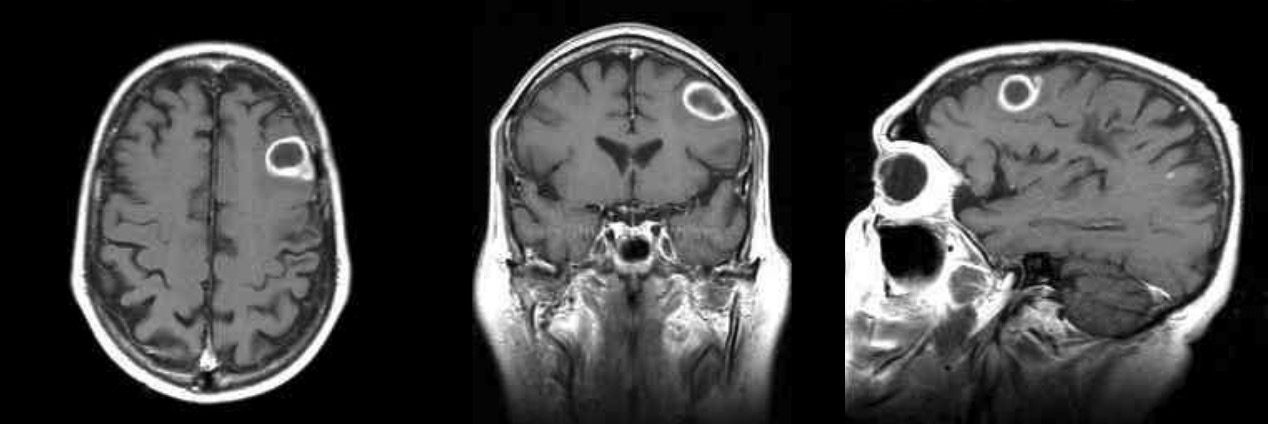Playlist
Show Playlist
Hide Playlist
Bacterial Meningitis: Examination
-
Slides CNS Infections Meningitis.pdf
-
Download Lecture Overview
00:00 How do we evaluate patients who present with meningitis? What are the signs? What do we look look for on exam? Well, the goal is to evaluate meningeal irritation. We want evidence that the meninges are thickened and inflamed and we're going to look at that in a number of ways. 00:16 The first is just to look for neck stiffness. Nuchal rigidity is stiffness of the neck to passive movement, both passive flexion of the neck as well as lateral movement of the neck. Nuchal rigidity is the medical word we use to mean neck stiffness. There are also 2 important signs, Kernig sign and Brudzinski sign. Kernig sign, I like Kernig because it has a K, it means we're manipulating the knee and this is a sign where patients will resist extension of the knee when the knee is flexed and you can see that here in this schematic. The knee is flexed to 90 degrees. The examiner is holding the patient's leg and passively pushing down on the knee, extending the knee and this causes pain and patients resist that movement. That suggests meningeal irritation. How about Brudzinski sign? Doesn't start with a K so we're not manipulating the knee. Brudzinski sign, the examiner is at the head. We have the patient lying flat, the examiner flexes the neck and the patients will passively elevate or flex their legs to reduce meningeal irritation. Again, each of these signs suggest that the meninges are thickened and inflamed, that there is meningeal stiffness and point to a problem in the meninges like meningitis. We can also see some secondary symptoms of meningeal irritation. 01:40 When the meninges are inflamed, cerebrospinal fluid may not drain or be reabsorbed appropriately. We know that the arachnoid granulations are extensions of the subarachnoid space into the venous sinuses. It's how the CSF drains and when those are clogged, CSF doesn't drain appropriately. So patients presenting late or with a chronic meningitis often will show signs of increased intracranial pressure. We look for that. With fundoscopy, we're looking for papilloedema and you can see that here. This is a fundoscopic examination, we're looking at the optic nerve head. It is not sharp and well demarcated. You can see that it's indistinct, the optic nerve head is pushed forward and it's hard to see that line, that cup of the optic nerve indicating too much pressure. The eyes, the optic nerves are popping out into the orbit and this indicates a concerning finding, a patient who needs to be evaluated rapidly. We look for abducens nerve palsies and we look at the abducens nerve. Bilateral abducens nerve palsy means increased intracranial pressure until proven otherwise. That's really important. 02:51 Bilateral 6-nerve palsies, the inability to look laterally indicates increased intracranial pressure until proven otherwise. So for example here we would ask the patient to gaze to the right and we see that the right eye won't look out. We would ask the patient to gaze to the left, and we see that the left eye does not look out. That's an abducens nerve palsy and bilateral abducens nerve palsies indicate increased intracranial pressure. Those patients need to be evaluated quickly. Ultimately, if the ICP is left unchecked, we can see Cushing's reflex, bradycardia, hypertension, and irregular respirations. That doesn't make sense. Usually when there is bradycardia, there is hypotension, but not for these patients. Bradycardia, hypertension, and irregular respirations and this means brainstem compromise. There could be herniation into the medulla and this is a life-threatening reflex and must be intervened upon emergently.
About the Lecture
The lecture Bacterial Meningitis: Examination by Roy Strowd, MD is from the course CNS Infections.
Included Quiz Questions
The appearance of resistance or pain during the extension of a patient's knees when the hips are flexed to 90 degrees is called...?
- ...Kernig's sign.
- ...Brudzinski's sign.
- ...McMurray's sign.
- ...Apley's sign.
- ...Kelly's sign.
Which of the following is true about Cushing's reflex?
- It is caused by impaired brainstem function.
- It occurs as a response to decreased intracranial pressure.
- It presents with bradycardia, hypotension, and irregular respirations.
- It is a transient reaction that resolves on its own.
- It occurs due to prolonged exposure to glucocorticoids.
Customer reviews
5,0 of 5 stars
| 5 Stars |
|
5 |
| 4 Stars |
|
0 |
| 3 Stars |
|
0 |
| 2 Stars |
|
0 |
| 1 Star |
|
0 |




